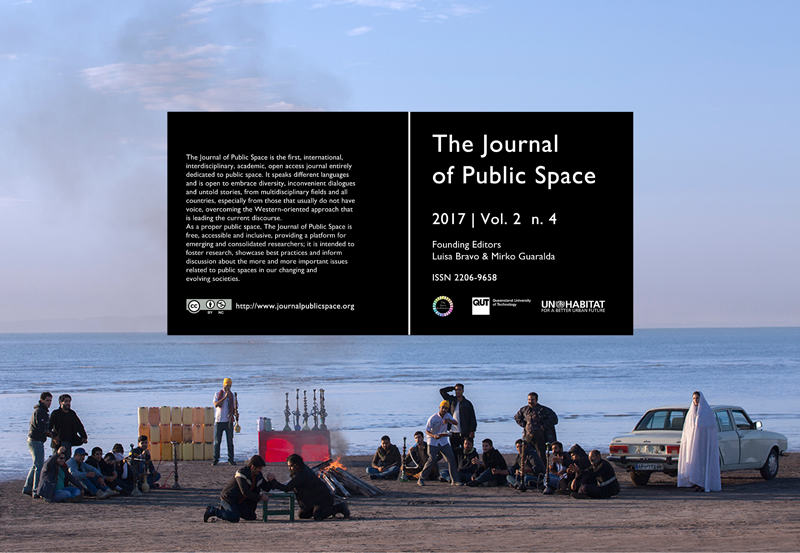New urban trends towards the use of public space in Turin
##plugins.themes.bootstrap3.article.main##
Abstract
What do we mean when we talk about public space? We asked this question, among others about the relationship between urban populations and public spaces, to some people in the context of the National Research Program (PRIN 2009) titled ‘Public Spaces, moving populations and urban renewal programs’. This paper reports part of the outcome of the research done within the local unit of Turin (Italy), which has been developed with a set of interviews to local stakeholders and with a field research in the selected areas of the City Centre and the districts of San Salvario and Barriera di Milano.
From the answers of the stakeholders emerged some relevant issues that I analysed through a selected literature about the concept of public space. The result is a sort of catalogue of typical public spaces of the city, as acknowledged by the local stakeholders and by the field research, and analysed through the international literature. The typologies identified are: traditional public spaces, ‘cappuccino’ spaces, weak sociality spaces, new virtual public spaces and the ‘District Houses’, a new type of public space emerging in the city. To identify them, some characteristic pictures of public spaces of Turin and interviews’ pieces are also reported.
However, facing this scenario built on the empirical research, we should mind that the conflicting views of public space depend also on the professional and cultural background of the interviewees, which is such fickle data that it cannot be catalogued. So, the catalogue proposed is not exhaustive, but only indicative of the trend about new perspectives on the meaning of public space which emerged through research conducted in the city of Turin.
##plugins.themes.bootstrap3.article.details##
The Authors retain copyright for articles published in The Journal of Public Space, with first publication rights granted to the journal.
Articles in this journal are published under the Creative Commons Attribution NonCommercial Licence (CC-BY-NC) - https://creativecommons.org/licenses/by-nc/4.0/.
You are free to:
• Share - copy and redistribute the material in any medium or format
• Adapt - remix, transform, and build upon the material
Under the following terms:
• Attribution - You must give appropriate credit, provide a link to the license, and indicate if changes were made. You may do so in any reasonable manner, but not in any way that suggests the licensor endorses you or your use.
• NonCommercial — You may not use the material for commercial purposes.
References
Augè, M. (1993). Non luoghi, Milano: Elèutera. (Original work: 1992, Non-lieux, Paris: Seuil).
Augè, M. (2013). Interview by C. Magnanimi, in D by La Repubblica, 9 march 2013: 116.
Crosta, P. L. (1996). “Connecting knowledge with action in the interactive porcess of planning: what knowledge is relevant and with whose actions are we connected?” in Planning Theory, 16.
European Commission (2003). Il partenariato con le città. L’Iniziativa comunitaria URBAN (Italian version), Printed in Begium.
Gehl, J. (1991). Vita in città. Spazio urbano e vita sociale, Roma: Maggioli. (Original work:1980, Livet mellem husen, Copenhagen: Arkitektens Forlag).
Granovetter M. (1998). “La forza dei legami deboli”, in Id., La forza dei legami deboli e altri saggi, Napoli: Liguori, p. 115-146) (Original work:1973, “The Strength of Weak Ties”, in American Journal of Sociology, 78: 1360-1380).
Jacobs, J. (1961). The Death and Life of Great American Cities, New York, NY: Random House.
La Cecla F. (2000). Perdersi. L’uomo senza ambiente, Roma-Bari: Laterza.
Mazzette, A. (2013). “Città tra privato e pubblico”, in Id. (ed.), Pratiche sociale di città pubblica, Roma-Bari: Editori Laterza.
Secchi B. (2000). Prima lezione di urbanistica, Roma-Bari: Laterza.
Sennet R. (1982). Il declino dell’uomo pubblico: la società intimista, Milano: Feltrinelli. (Original work published 1977: The fall of public man, New York: Knopf).
Sitte C. (1996). L'arte di costruire le città, Jaca Book: Milano. (Original work published 1889, Der Stadte-Bau nach seinen Kunstlerschen Grundsatzen, Wien).
Zukin S. (1995). The Cultures of Cities, Oxford: Blackwell.
Zukin S. (1998). “Politics and aesthetics of public space: the ‘American model’ “, Published in Ciutat real, ciutat ideal. Significat i funció a l'espai urbà modern [Real city, ideal city. Signification and function in modern space]. Barcelona: Centre de Cultura Contemporània de Barcelona, 1998 (Urbanitats; 7).

